概要
単語分析は、検索エンジンの重要な基本機能です。分析の効果は、検索結果に直接影響します。さまざまなビジネスシナリオにおいて、さまざまな業界のお客様には特別な要件があります。お客様ごとのアプリケーションに特化したカスタマイズされた分析のみが、各お客様の分析要件を満たすことができます。
OpenSearch Industry Algorithm Edition は、さまざまな顧客の分析要件に対応するために、調整済み検索モデルを提供します。OpenSearch Industry Algorithm Edition は、さまざまな業界固有のアナライザーを提供します。ビジネス要件に基づいて業界固有のアナライザーを選択して、調整済み検索モデルを作成およびトレーニングし、トレーニング済みモデルに基づいてカスタムアナライザーを作成できます。プロセス全体を通して、アプリケーションにデータをインポートする必要はありません。調整済み検索モデルをトレーニングすると、システムはアプリケーションの既存のデータを自動的に抽出し、アプリケーションのビジネスロジックに基づいてデータを分析します。
調整済み検索モデルは、ストレージ容量、コンピューティングリソース、およびモデルのトレーニングに基づいて課金されます。詳細については、概要に記載されている請求方法を参照してください。
調整済み検索モデルの作成
調整済み検索モデルを使用する前に、次の手順を実行します。
モデルを作成してトレーニングします。
カスタムアナライザーを作成します。
カスタムアナライザーを構成します。
モデルの作成とトレーニング
左側のナビゲーションペインで、[検索アルゴリズムセンター] > [検索設定] を選択します。[検索設定] ページが表示されます。左側のペインで、[調整済み検索モデル] をクリックします。表示されるページで、調整済み検索モデルを作成する専用のアプリケーションを選択し、作成をクリックします。
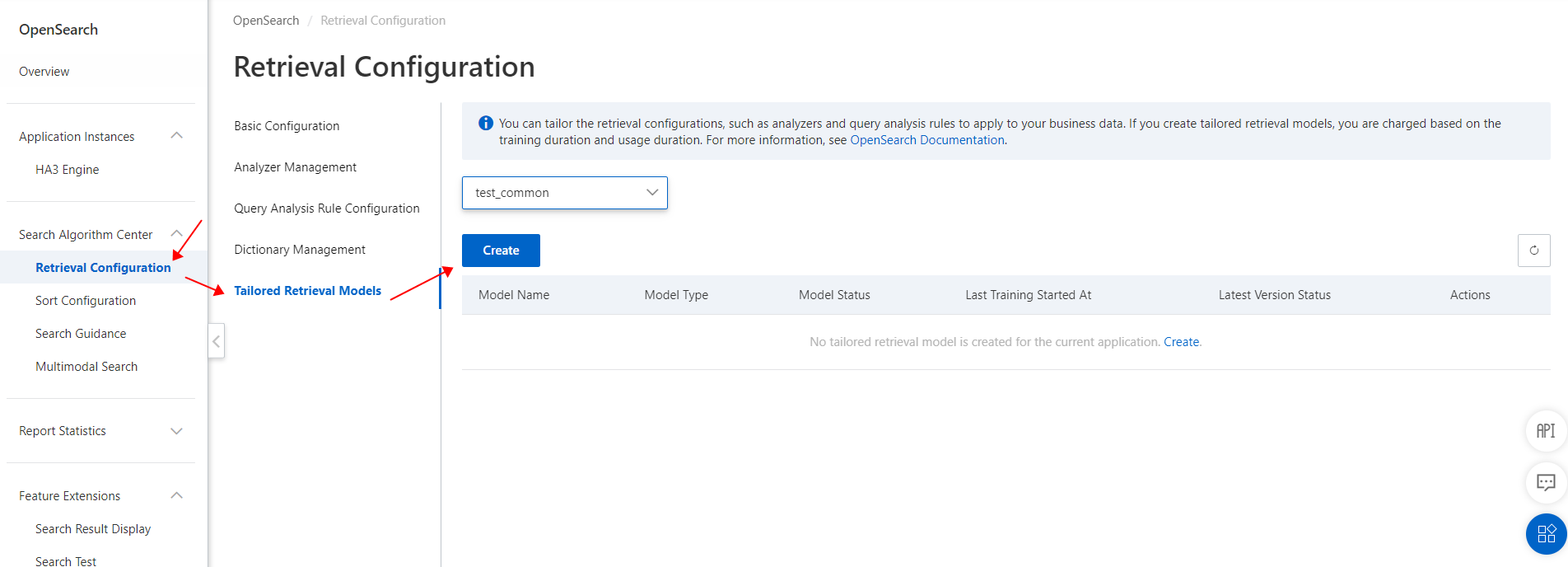
モデル名、モデルタイプ、基本アナライザー、トレーニングフィールド、および正規化パラメーターを構成し、送信をクリックします。
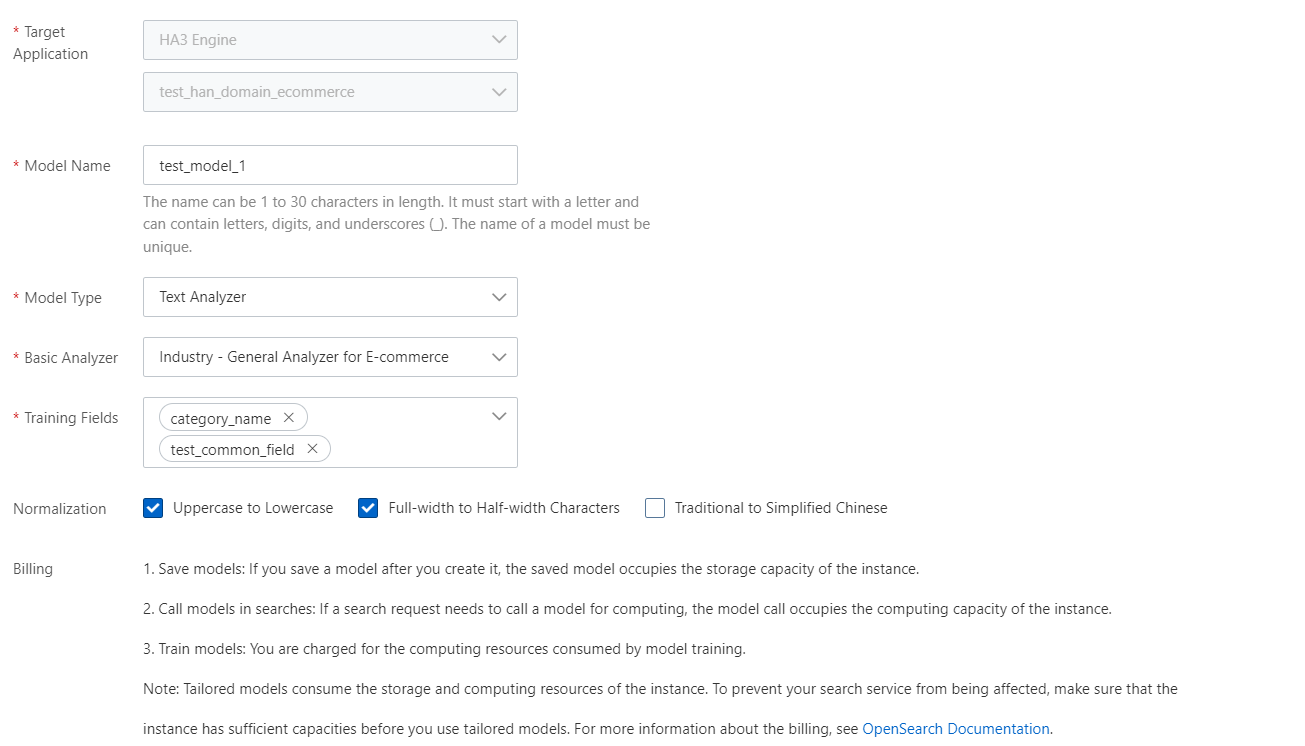
[基本アナライザー] ドロップダウンリストから、次のオプションのいずれかを選択できます。中国語 - 一般アナライザー、中国語 - E コマースアナライザー、IT - コンテンツアナライザー、業界 - ゲーム用一般アナライザー、業界 - 教育 Q&A 検索用アナライザー、業界 - IT コンテンツ分析、業界 - E コマース用一般アナライザー。
[正規化] パラメーターには、大文字を小文字に変換、繁体字を簡体字に変換、全角文字を半角文字に変換のいずれか1つ以上の値を指定できます。このパラメーターはオプションです。このパラメーターは検索を実行するときにのみ有効になり、元のフィールドの内容には影響しないことに注意してください。
モデルの作成後、モデル名は変更できません。
[トレーニングフィールド] パラメーターには、SHORT TEXT または TEXT データ型のフィールドのみを指定できます。
モデルの作成後、デフォルトでは使用不可の状態になります。[調整済み検索モデル] ページで、作成したモデルの [アクション] 列にあるトレーニングをクリックします。
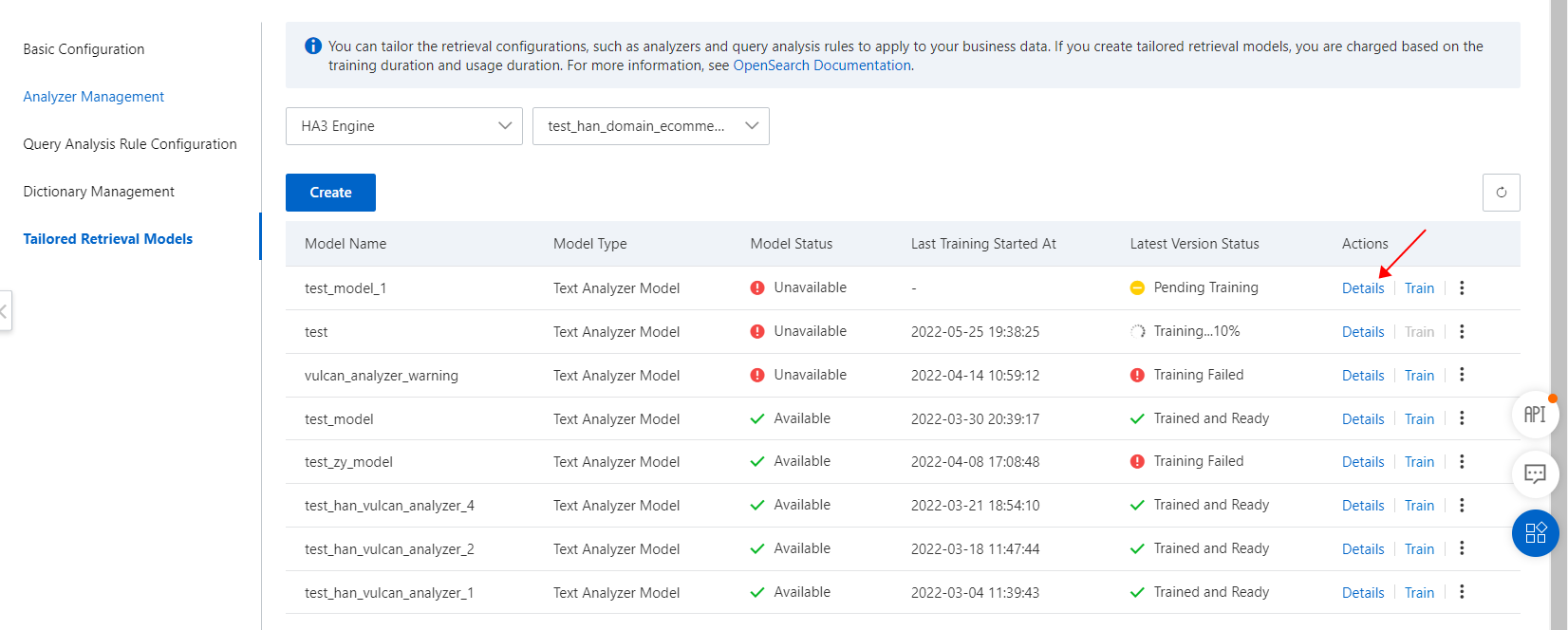
ほとんどの場合、モデルのトレーニングは完了するまでに1~2営業日かかります。
モデルは繰り返しトレーニングできます。モデルのトレーニングが完了するたびに、モデルの詳細ページのトレーニング履歴セクションにモデルバージョンが追加されます。バージョン番号は1ずつ増加します。
カスタムアナライザーの作成
調整済み検索モデルがトレーニングされ、モデルが利用可能状態になったら、カスタムアナライザーを作成および構成できます。
左側のナビゲーションペインで、検索アルゴリズムセンター > 検索設定 を選択します。検索設定ページが表示されます。左側のペインで、アナライザー管理をクリックします。表示されるページで、テキストアナライザータブをクリックします。次に、作成をクリックします。

表示されるパネルで、名前を入力し、アナライザーの種類としてTailored Model Analyzer を選択し、HA3 エンジンインスタンスを選択してから、作成した調整済み検索モデルを選択します。次に、保存 をクリックします。
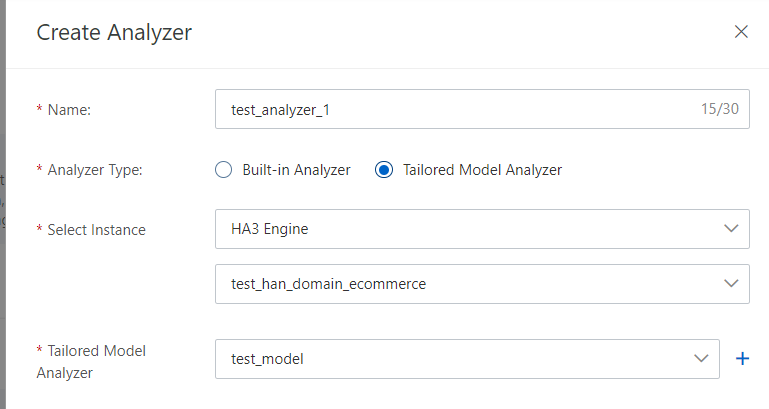
カスタムアナライザーを作成したら、カスタムアナライザーを使用して、単語分析が期待どおりに実行されるかどうかをテストし、エントリを管理できます。

カスタムアナライザーの構成
カスタムアナライザーの作成後、オフライン変更操作を実行して、カスタムアナライザーをインデックスに反映させることができます。
左側のナビゲーションペインで、[インスタンス管理] > [HA3 エンジン] を選択します。表示されるページで、管理するアプリケーションを見つけ、[アクション] 列の [詳細] をクリックします。表示される詳細ページで、オフラインアプリケーションの変更をクリックします。
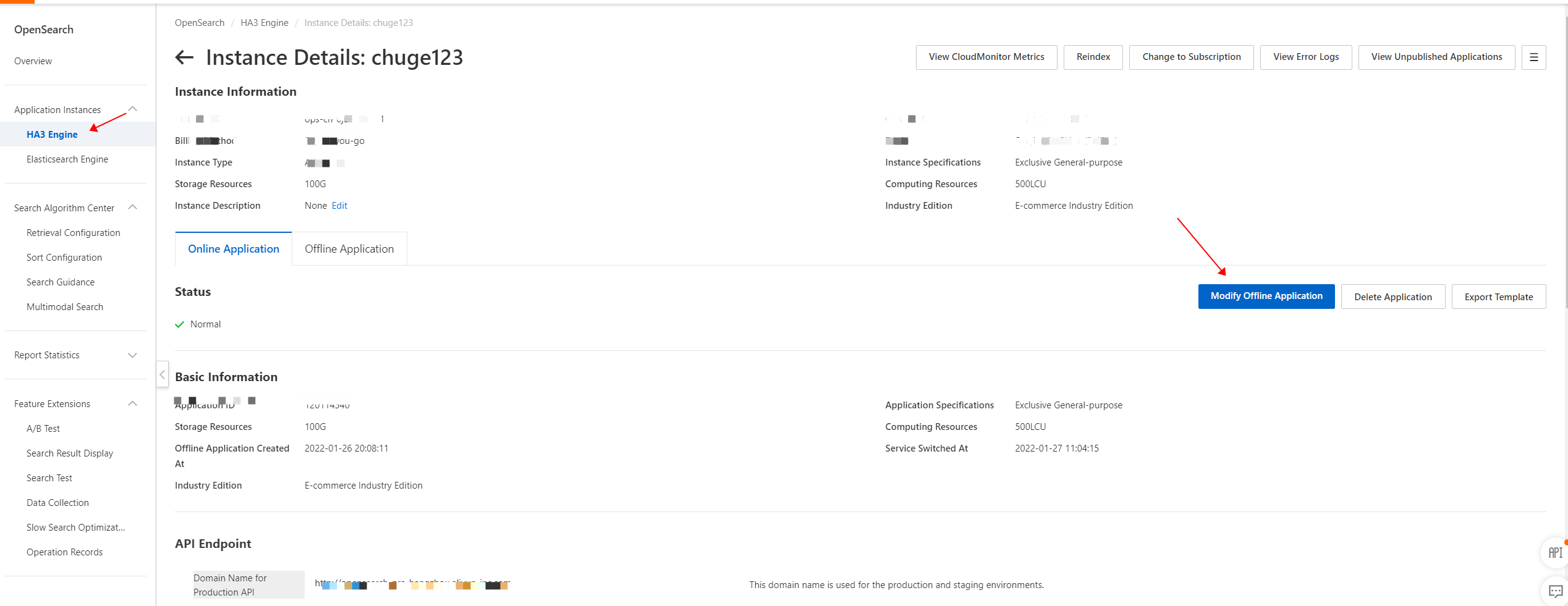
[インデックススキーマ] ステップで、対応するインデックスを見つけます。[分析方法] 列で、調整済み検索モデルを構成したカスタムアナライザーを指定し、使用するモデルバージョンを選択します。
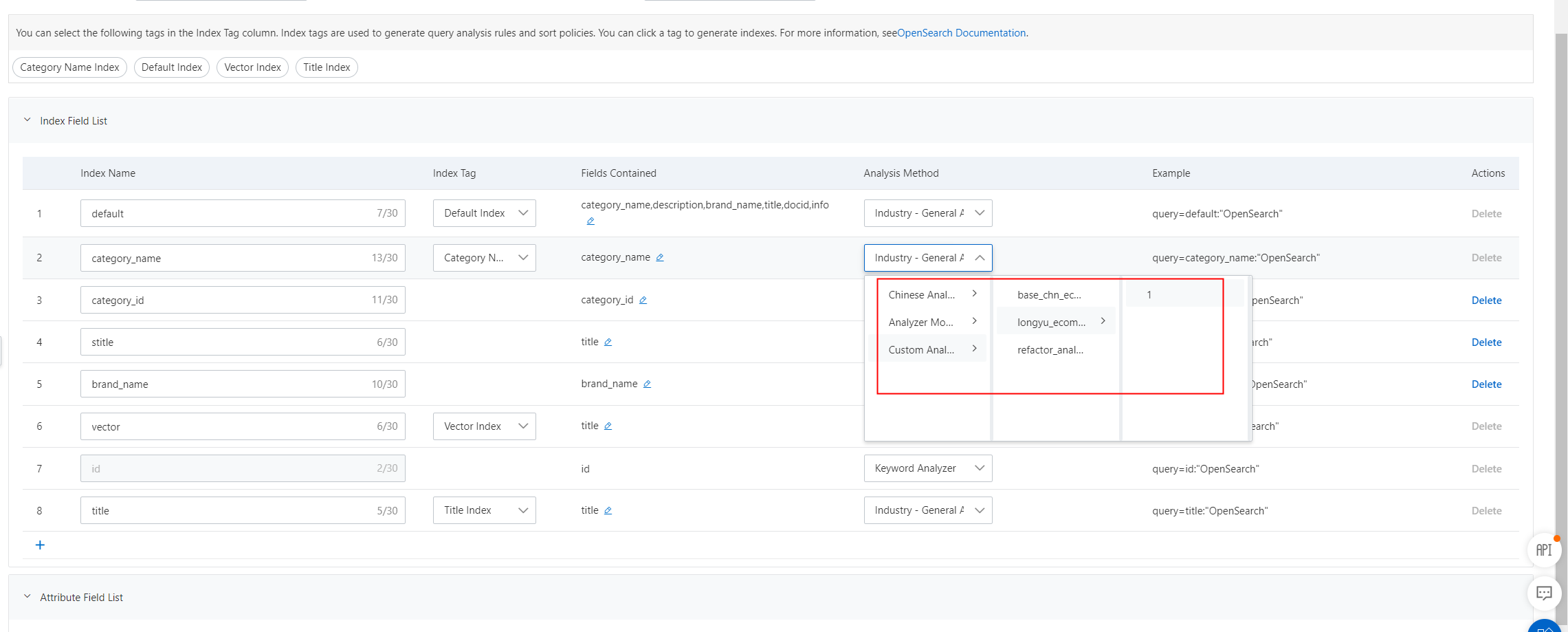
オフライン変更操作が完了したら、インデックスが再構築されるまで待ちます。

インデックスが再構築されたら、検索テストページで調整済み検索モデルの効果をテストできます。

詳細ページ
調整済み検索モデルページ

[調整済み検索モデル] ページでは、モデル名、モデルタイプ、モデルステータス、最後のトレーニングの開始時刻、最新バージョンのステータスなど、各調整済み検索モデルに関する情報を表示できます。調整済み検索モデルは、利用可能または利用不可の状態になります。また、各調整済み検索モデルの [アクション] 列の [詳細]、[トレーニング]、または [削除] をクリックして、モデルの詳細の表示、モデルのトレーニング、またはモデルの削除を行うこともできます。
インデックスによって参照されている調整済み検索モデルは削除できません。
調整済み検索モデルの最新バージョンがトレーニング中の場合、[アクション] 列の [再トレーニング] ボタンはグレー表示され、使用できません。調整済み検索モデルの最新バージョンがトレーニング中でない場合は、[再トレーニング] をクリックしてモデルを再トレーニングできます。
調整済み検索モデルの詳細ページ
調整済み検索モデルの詳細ページは、次の3つのセクションで構成されています。
基本情報:このセクションでは、作成時刻、モデルステータス、最後のトレーニングの開始時刻、最新バージョンのステータスなど、調整済み検索モデルに関する基本情報のみを表示できます。
構成情報:このセクションでは、調整済み検索モデルの作成または構成時に指定した構成のみを表示できます。構成には、基本アナライザー、トレーニングフィールド、正規化設定が含まれます。
トレーニング履歴:このセクションでは、モデルバージョン、構成情報、バージョンステータス、トレーニングの開始時刻、トレーニングの終了時刻、調整済み検索モデルを参照するインデックスなどの情報を表示できます。また、モデルの効果をテストすることもできます。
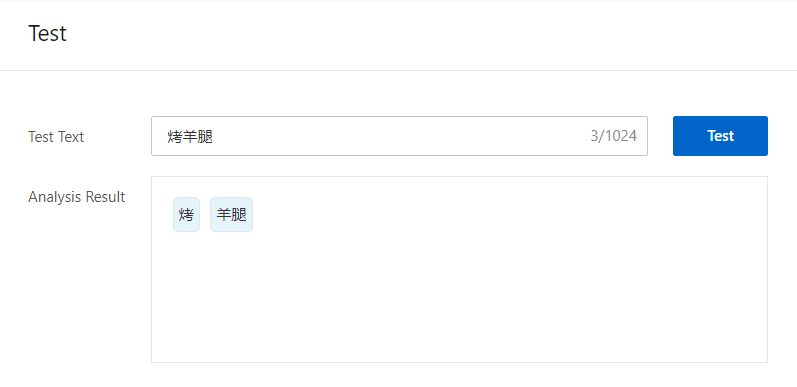
一般的なケースで調整済み検索モデルの効果を比較し、比較結果をダウンロードできます。

制限事項
この機能は、Industry Algorithm Edition - 専用クラスターインスタンスでのみ使用できます。
単一のインスタンスで作成できる調整済み検索モデルは最大5つです。
調整済み検索モデルは特定のアプリケーションに対して作成され、アプリケーション間で構成することはできません。
テキストアナライザーのみをカスタマイズできます。